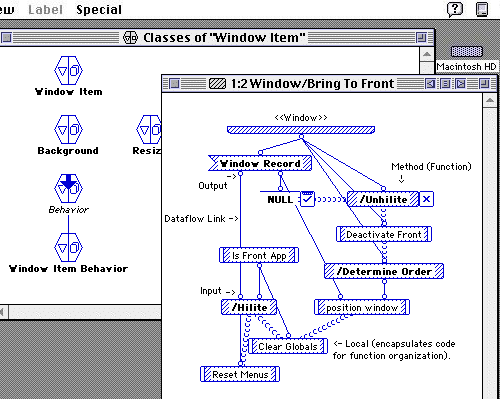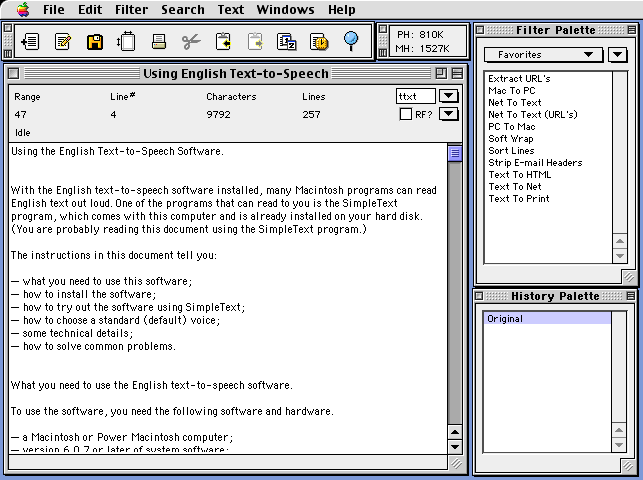TextSpresso History
A text editor with a twist, TextSpresso was the first commercial grade application created and published by Daniel L. Taylor. The idea behind TextSpresso was to create an editor centered around a set of programmable filters that could be saved, shared, and used to automate tedious tasks. When version 1.0 shipped for Mac OS classic it included 7 core filter types, a library of 83 built in filters, 100 levels of undo, a batch processor, and a fully multithreaded design. It was an overnight shareware success receiving multiple 5 star reviews and awards from the Macintosh press.
TextSpresso 1.0 was written in a unique language called Prograph. In Prograph you would literally draw code as data flow diagrams. The text filtering engine was written in C for performance and memory efficiency. At the time of its release TextSpresso was one of the fastest text editors on any platform. Files which were too large to be opened by many competing products could be filtered in seconds with TextSpresso. Which was quite an accomplishment at a time when the average Mac had a 66 MHz CPU and 8-16 MB of RAM.

With Apple’s transition to the new Carbon API Pictorius, the developers of Prograph, decided to open source their application framework so that the community could contribute to the effort to modernize it. Taylor Design took the lead in the effort to modernize the Application Builder Classes or ABCs. As work progressed it became clear that parts of the Prograph runtime, which was written in C++ and had not been open sourced, were not Carbon compliant. Taylor Design stepped in and created a replacement library in C++ that could be linked with Pictorius’ libraries to produce a 100% Carbon ready runtime, and provided this critical resource for free to the Prograph community.
TextSpresso 2.0 soon shipped for Mac OS X. Unfortunately it was a short lived project. Pictorius was one of the companies that did not survive the shake up caused by Apple’s OS X transition, and Prograph languished as investors tried to form a new company rather than fully open sourcing the language. Pictorius had created an advanced language and framework with some features that are rare or non existent even in todays languages. But it was time to move on.
At this point Taylor Design rewrote TextSpresso using Real Studio, which is now known as Xojo. While it was tempting to rewrite TextSpresso using Apple’s Xcode, Xojo offered the significant advantage of being able to target multiple OSes from a single code base. And unlike other tools such as Java, Xojo compiles native applications. Taylor Design had previously taken advantage of this powerful language to help clients who needed to ship applications for Mac and Windows, and decided to do the same with TextSpresso. TextSpresso 3 shipped as a Xojo application, with the original high performance C filtering engine, for both Mac OS X and Windows. It was a seamless transition for end users who could still use all their old filters, and for the first time exchange them across platforms.
Over the years TextSpresso has grown to include a total of 12 filter types and 290 filters. Unfortunately work on TextSpresso slowed during the late 2000’s. It is still available here and it still runs on the latest versions of Mac OS X and Windows. But it has not seen anything other than maintenance releases in quite some time.
We are finally dusting it off and moving it in a new direction. We’re not going to give out much information yet, but TextSpresso 4 is coming.

